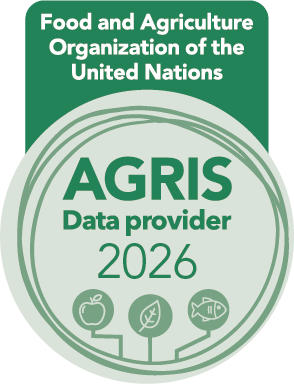Optimizing growth, yield, and nutritional quality of Chinese cabbage throughvermicompost and reduced fertilizer application in organic farming systems
DOI:
https://doi.org/10.24154/jhs.v19i2.3194Keywords:
Chinese cabbage, organic farming, vegetables, vermicompostAbstract
Chinese cabbage, though less prominent in Bangladesh, has shown potential for successful cultivation in the region. This study aimed to assess various cultivars’ efficacy on Chinese cabbage growth, yield, and quality within an organic farming system. A field experiment was conducted for two consecutive years, investigating the combined impact of cultivar and vermicompost with reduced fertilizer levels on yield. Three cultivars, viz., BARI Chinakopi 1, Blues, and Retasi, were tested along with four fertilizer levels: recommended NPK (control); 80% NPK + vermicompost 6 t/ha; 70% NPK + vermicompost 8 t/ha; and 50% NPK + vermicompost 10 t/ha. Results demonstrated that cv. Blues, treated with 50% NPK + 10 t/ha of vermicompost, exhibited significant enhancements in various parameters compared to the control group. Notably, the treated variety Blues showcased increased plant height (43%), head diameter (46.3%), dry matter (71.2%), and gross yield (72.2%) at harvest. Moreover, var. Blues treated with vermicompost at 10 t/ha displayed elevated levels of vitamin C (28%), β-carotene (96.3%), Ca (7.1%), Mg (18.4%), P (5%), K (10.5%), Fe (13.1%), and Zn (21%) compared to control. These findings suggest that utilizing 50% NPK + vermicompost at 10 t/ha significantly enhances Chinese cabbage growth and quality, particularly in cv. Blues. Incorporating this treatment method could effectively elevate both production yield and crop quality, providing valuable insights for organic farming practices.
Downloads
References
Adhikari, R., Katel, S., Chhetri, P. K., Simkhada, P., Chaudhari, P., & Yadav, S. P. S. (2023). Effect of different sources of organic fertilizers on crop growth and yield of cabbage. Journal of Agriculture and Applied Biology, 4(1), 83–94.
Alam, M. A. U., Hoque, M. E., Laily, U. K., Khatun, M. U. S., Islam, M. K., & Mollah, S. H. (2017). Growth and yield performance of cabbage under different combinations of vermicompost and fertilizers. International Journal of Advanced Research in Biological Sciences, 4(6), 79–86.
Ali, S., & Kashem, M. A. (2018). Effect of vermicompost on the growth and yield of cabbage. Journal of Agricultural Engineering and Food Technology, 5(1), 45–49.
Al-Tawarah, B., Alasasfa, M. A., & Mahadeen, A. Y. (2024). Efficacy of compost and vermicompost on growth, yield and nutrient content of common beans crop (Phaseolus vulgaris L.). Journal of Ecological Engineering, 25(2), 215–226.
AOAC. (1994). Official methods of analysis (Association of Official Analytical Chemists). AOAC, Washington, D.C.
Biswas, A. K., Sahoo, J., & Chatli, M. K. (2011). A simple UV-Vis spectrophotometric method for determination of β-carotene content in raw carrot, sweet potato and supplemented chicken meat nuggets. LWT-Food Science and Technology, 44(8), 1809–1813.
Farjana, S., Islam, M. A., & Haque, T. (2019). Effects of organic and inorganic fertilizers, and mulching on growth and yield of cabbage (Brassica oleracea var. capitata L.). Journal of Horticulture and Postharvest Research, 2(2), 95–104.
Francioli, D., Schulz, E., Lentendu, G., Wubet, T., Buscot, F., & Reitz, T. (2016). Mineral vs. organic amendments: Microbial community structure, activity and abundance of agriculturally relevant microbes are driven by long-term fertilization strategies. Frontiers in Microbiology, 7, Article 1446. https://doi.org/10.3389/fmicb.2016.01446
Gong, X., Li, S., Carson, M., Chang, S., Wu, Q., Wang, L., An, Z., & Sun, X. (2019). Spent mushroom substrate and cattle manure amendments enhance the transformation of garden waste into vermicomposts using the earthworm Eisenia fetida. Journal of Environmental Management, 248, 109263. https://doi.org/10.1016/j.jenvman.2019.109263
Haque, T. (2023). Effects of application of nitrogen and vermicompost on growth performance and yield of Bari Chinashak-1 (Brassica chinensis L.). Journal of Agriculture, Food and Environment (JAFE), 4(3), 21–26.
Hasan, M. J., Khatun, K., Mostarin, T., Karishma, K. C., Nadim, M. K. A., & Chowdhury, S. M. A. (2024). Influence of vermicompost and biofertilizer on growth, head yield and quality of broccoli (Brassica oleracea L. var. italica). Agricultural Science & Technology, 16(1).
Jadhav, A. B., Gosavi, A. B., Jadhav, S. A., & Patil, A. V. (2024). Influence of different substrates on nutrient composition of vermicompost and vermiwash. International Journal of Plant & Soil Science, 36(6), 340–352.
Kalisz, A., Kostrzewa, J., Sekara, A., Grabowska, A., & Cebula, S. (2012). Yield and nutritional quality of several non-heading Chinese cabbage (Brassica rapa var. chinensis) cultivars with different growing period and its modelling. Horticultural Science & Technology, 30(6), 650–656.
Najafi-Ghiri, M. (2014). Effects of zeolite and vermicompost applications on potassium release from calcareous soils. Soil and Water Research, 9(1), 31–37.
Nurhidayati, N., Ali, U., & Murwani, I. (2016). Yield and quality of cabbage (Brassica oleracea L. var. capitata) under organic growing media using vermicompost and earthworm Pontoscolex corethrurus inoculation. Agriculture and Agricultural Science Procedia, 11, 5–13.
Pour, A. A., Moghadam, A. R. L., & Ardebili, Z. O. (2013). The effects of different levels of vermicompost on the growth and physiology of cabbage seedlings. International Research Journal of Applied and Basic Sciences, 4(9), 2726–2729.
Reza, M. S., Islam, A. K. M. S., Rahman, M. A., Miah, M. Y., Akhter, S., & Rahman, M. M. (2016). Impact of organic fertilizers on yield and nutrient uptake of cabbage (Brassica oleracea var. capitata). Journal of Science, Technology and Environment Informatics, 3(2), 231–244.
Seong, G. U., Hwang, I. W., & Chung, S. K. (2016). Antioxidant capacities and polyphenolics of Chinese cabbage (Brassica rapa L. ssp. pekinensis) leaves. Food Chemistry, 199, 612–618.
Shi, L., Zheng, W., Lei, T., Liu, X., & Hui, M. (2021). The effect of different soil amendments on soil properties and on the morphological and physiological characteristics of Chinese cabbage. Journal of Soil Science and Plant Nutrition, 21, 1500–1510. https://doi.org/10.1007/s42729-021-00456-6
Šimon, T., & Czakó, A. (2018). Influence of long-term application of organic and inorganic fertilizers on soil properties. Plant Soil and Environment, 60, 314–319. https://doi.org/10.17221/264/2014-PSE
Song, C., Ye, X., Liu, G., Zhang, S., Li, G., Zhang, H., Li, F., Sun, R., Wang, C., Xu, D., & Zhang, S. (2023). Comprehensive evaluation of nutritional qualities of Chinese cabbage (Brassica rapa ssp. pekinensis) varieties based on multivariate statistical analysis. Horticulturae, 9(12), 1264. https://doi.org/10.3390/horticulturae9121264
Vennila, C., Jayanthi, C., & Sankaran, V. M. (2012). Vermicompost on crop production—A review. Agricultural Reviews, 33(3), 265–270.
Wang, D., Shi, Q., Wang, X., Wei, M., Hu, J., Liu, J., & Yang, F. (2010). Influence of cow manure vermicompost on the growth, metabolite contents, and antioxidant activities of Chinese cabbage (Brassica campestris ssp. chinensis). Biology and Fertility of Soils, 46, 689–696.
Downloads
Published
Issue
Section
License
Copyright (c) 2024 Nishat Islam, Minhazul Kashem Chowdhury, Soumitro Biswas, Jasim Uddain (Author)

This work is licensed under a Creative Commons Attribution-NonCommercial-ShareAlike 4.0 International License.
Authors retain copyright. Articles published are made available as open access articles, distributed under the terms of the Creative Commons Attribution-NonCommercial-ShareAlike 4.0 International License, which permits unrestricted non-commercial use, distribution, and reproduction in any medium, provided the original author and source are credited. 
This journal permits and encourages authors to share their submitted versions (preprints), accepted versions (postprints) and/or published versions (publisher versions) freely under the CC BY-NC-SA 4.0 license while providing bibliographic details that credit, if applicable.







 .
. 











